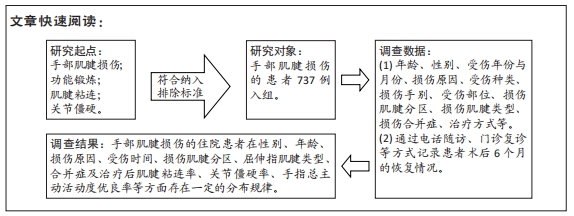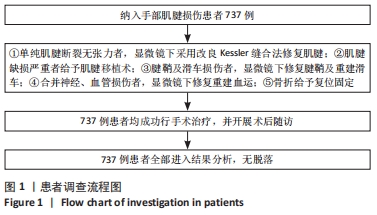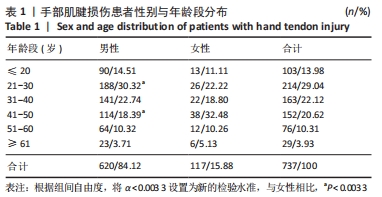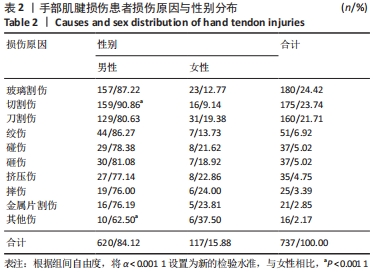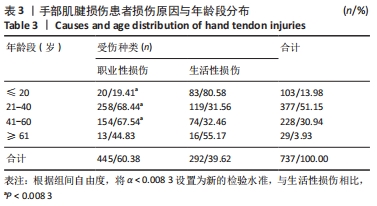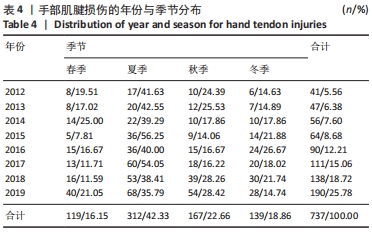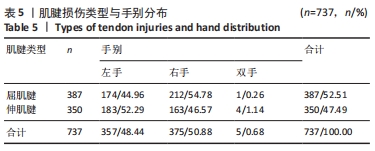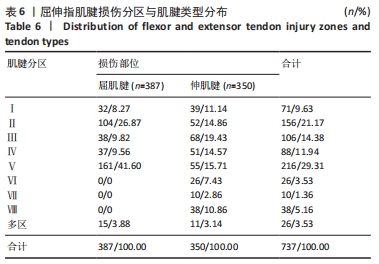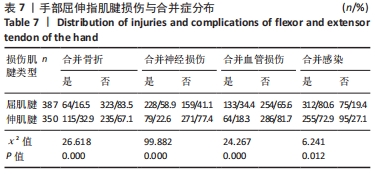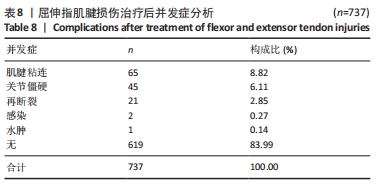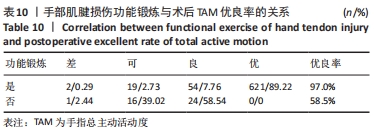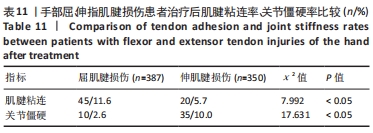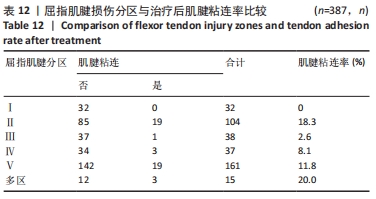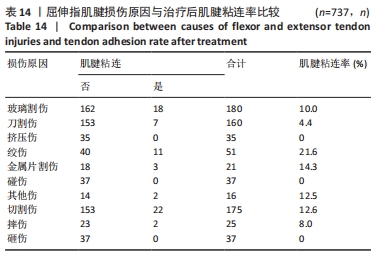[1] LEE JS, KIM YH. Factors associated with limited hand motion after hand trauma. Medicine (Baltimore). 2019;98(3):e14183.
[2] THANGAVELU M, VEERASAMY N, KANTHAN A. Study on evaluation and management of hand injuries. J Evol Med Dent Sci. 2016;5(66):4703-4707.
[3] POLINDER S, IORDENS GI, PANNEMAN MJ, et al. Trends in incidence and costs of injuries to the shoulder, arm and wrist in The Netherlands between 1986 and 2008. BMC Public Health. 2013;13:531.
[4] 强力, 薛明宇, 卜凡玉, 等. 游离腕横纹嵌合皮瓣修复手指复合组织缺损八例[J]. 中华显微外科杂志,2017,40(4):371-373.
[5] 李红斌. 手部指屈肌腱损伤修复治疗的临床观察[J]. 中外医学研究, 2018,16(34):131-133.
[6] 夏尚, 李鑫, 潘艳丽, 等. 手部指屈肌腱损伤修复治疗的临床分析[J]. 中外医学研究,2017,15(31):69-70.
[7] 高君, 王维, 那磊, 等. 肌腱粘连的预防:现状和进展[J]. 中国组织工程研究,2014,18(46):7515-7519.
[8] MOLLOY T, WANG Y, MURRELL G. The roles of growth factors in tendon and ligament healing. Sports Med. 2003;33(5):381-394.
[9] HUNTER JM, SALISBURY RE. Flexor-tendon reconstruction in severely damaged hands. A two-stage procedure using a silicone-dacron reinforced gliding prosthesis prior to tendon grafting. J Bone Joint Surg Am. 1971;53(5):829-858.
[10] RIGO IZ, ROKKUM M. Predictors of outcome after primary flexor tendon repair in zone 1, 2 and 3. J Hand Surg Eur. 2016;41(8):793-801.
[11] LILLY SI, MESSER TM. Complications after treatment of flexor tendon injuries. J Am Acad Orthop Surg. 2006;14(7):387-396.
[12] TANG JB. Clinical outcomes associated with flexor tendon repair. Hand Clin. 2005;21(2):199-210.
[13] AMADIO P, AN KN, EJESKAR A, et al. IFSSH Flexor Tendon Committee report. J Hand Surg Br. 2005;30(1):100-116.
[14] 汤锦波. 手屈指肌腱损伤的临床修复效果[J]. 中华创伤骨科杂志, 2006,8(1):8-12.
[15] DE JONG JP, NGUYEN JT, SONNEMA AJ, et al. The incidence of acute traumatic tendon injuries in the hand and wrist: a 10-year population-based study. Clin Orthop Surg. 2014;6(2):196-202.
[16] GIUSTINI M, DE LEO A, LETI ACCIARO A, et al. Incidence estimates of hand and upper extremity injuries in Italy. Ann Ist Super Sanita. 2015; 51(4):305-312.
[17] CHANG MK, TAY SC. Flexor Tendon Injuries and Repairs: A Single Centre Experience. J Hand Surg Asian Pac. 2018;23(4):487-495.
[18] 胡朝阳, 刘鸣江. 手外伤流行病学研究现状[J]. 现代医药卫生, 2014,30(23):3568-3570.
[19] 刘士波, 孙勃, 李小东,等. 某三甲医院手外伤病因与发病特点的调查分析[J]. 世界最新医学信息文摘,2018,18(43):253-255.
[20] 福嘉欣, 江毅, 朱红,等. 673例成人职业性手外伤的流行病学调查[J]. 中华劳动卫生职业病杂志,2015,33(10):769-770.
[21] KASKUTAS V, POWELL R. The impact of flexor tendon rehabilitation restrictions on individuals’ independence with daily activities: implications for hand therapists. J Hand Ther. 2013;26(1):22-28; quiz 29.
[22] RAMEL E, ROSBERG HE, DAHLIN LB, et al. Return to work after a serious hand injury. Work. 2013;44(4):459-469.
[23] DOCHEVA D, MULLER SA, MAJEWSKI M, et al. Biologics for tendon repair. Adv Drug Deliv Rev. 2015;84:222-239.
[24] 江克罗, 张文正, 黎小艇, 等. 掌背动脉顺行皮瓣修复手背皮肤软组织缺损的临床应用[J]. 中华手外科杂志,2018,34(5):385-386.
[25] 詹宏钢, 汤样华, 徐灿达,等. 复合组织瓣移植修复伴有伸肌腱缺损的指背软组织缺损创面[J]. 中华手外科杂志,2020,36(3):238-240.
[26] 常红, 安晓飞, 王辉, 等. 多类型桡动脉掌浅支腕横纹部游离皮瓣在手指复合软组织缺损治疗中的应用研究[J]. 中华骨与关节外科杂志,2021,14(8):688-692.
[27] 杜冬, 庄永青, 傅小宽, 等. 手部屈肌腱损伤的早期显微外科修复[J]. 中华手外科杂志,2003,19(1):53.
[28] CALISKAN UCKUN A, YURDAKUL FG, ERGANI HM, et al. Factors predicting reoperation after hand flexor tendon repair. Ulus Travma Acil Cerrahi Derg. 2020;26(1):115-122.
[29] GOJOWY D, HOMANN HH, SCHREIER D. [Flexor tendon injuries of the hand]. Chirurg. 2020;91(10):895-902.
[30] KLIFTO CS, BOOKMAN J, PAKSIMA N. Postsurgical Rehabilitation of Flexor Tendon Injuries. J Hand Surg Am. 2019;44(8):680-686.
[31] 杜传林, 李朋, 杨广友, 等. 手Ⅱ区屈肌腱损伤修复及康复治疗的临床观察[J]. 解放军医学杂志,2014,39(12):1008-1009.
[32] AKBARI H, RAHIMI AA, GHAVAMI Y, et al. Effect of Heparin on Post-Operative Adhesion in Flexor Tendon Surgery of the Hand. J Hand Microsurg. 2015;7(2):244-249.
[33] WU YF, TANG JB. Effects of tension across the tendon repair site on tendon gap and ultimate strength. J Hand Surg Am. 2012;37(5):906-912.
[34] 李春江. 埋入式双套索锁扣结错位缝合法修复Ⅱ区指屈肌腱损伤[J]. 中华手外科杂志,2016,32(1):22-24.
[35] 胡利, 叶红梅, 黄晓瑜, 等. 手部肌腱损伤病人手术护理及功能锻炼[J]. 牡丹江医学院学报,2016,37(4):136-137.
[36] STAUBER T, BLACHE U, SNEDEKER JG. Tendon tissue microdamage and the limits of intrinsic repair. Matrix Biol. 2020;85-86:68-79.
[37] KOEHLER SV, SAUERBIER M, TERZIS A. Rupture Rate, Functional Outcome and Patient Satisfaction after Primary Flexor Tendon Repair with the Modified 4-Strand Core Suture Technique by Tsuge and Using the Arthrex FiberLoop((R)) with Early Motion Rehabilitation. J Clin Med. 2021;10(19):4538.
[38] 石金柱, 马学忠, 朱亚斌, 等. Ishiguro法治疗伸肌腱止点开放性骨折[J]. 实用手外科杂志,2018,32(4):437-438.
[39] 杜启军,梁王班. 显微外科技术配合中药熏洗治疗肌腱损伤对肌腱粘连的预防作用[J]. 中医临床研究,2015,7(21):104-105.
[40] 刘伟. Ⅱ区指屈肌腱损伤患者在修复术后实施虚拟情景反馈训练对手功能的恢复作用[J]. 创伤外科杂志,2018,20(6):443-445.
[41] 姜大伟,贾全章,侯明晓,等. 伸指肌腱损伤后交指样显微编织缝合术加玻璃酸钠防粘连治疗的实验研究[J]. 中国矫形外科杂志, 2009,17(14): 1090-1092.
[42] MANNINEN M, KARJALAINEN T, MÄÄTTÄ J, et al. Epidemiology of Flexor Tendon Injuries of the Hand in a Northern Finnish Population. Scand J Surg. 2017;106(3):278-282.
[43] MICHEL PA, KRONENBERG D, NEU G, et al. Microsurgical reconstruction affects the outcome in a translational mouse model for Achilles tendon healing. J Orthop Translat. 2020;24:1-11.
[44] NEUWIRTH M, BÜRGER H, PALLE W, et al. One-stage reconstruction of isolated and combined tendon defects with the vascularized adductor magnus tendon graft: Surgical technique and preliminary results. J Plast Reconstr Aesthet Surg. 2016;69(7):928-935.
[45] TANG Y, LI Y. Effectiveness of microsurgical repair of flexor tendon rupture by non-knot Kessler suture method in anastomotic stoma]. Zhongguo Xiu Fu Chong Jian Wai Ke Za Zhi. 2011;25(10):1210-1213.
[46] KREY D, BORCHERS J, MCCAMEY K. Tendon needling for treatment of tendinopathy: A systematic review. Phys Sportsmed. 2015;43(1):80-86.
[47] DY CJ, HERNANDEZ-SORIA A, MA Y, et al. Complications after flexor tendon repair: a systematic review and meta-analysis. J Hand Surg Am. 2012;37(3): 543-551.e541.
[48] FUJIHARA Y, OTA H, WATANABE K. Utility of early active motion for flexor tendon repair with concomitant injuries: A multivariate analysis. Injury. 2018;49(12):2248-2251.
[49] BIGORRE N, DELAQUAIZE F, DEGEZ F, et al. Primary flexor tendons repair in zone 2: Current trends with GEMMSOR survey results. Hand Surg Rehabil. 2018;37(5):281-288.
[50] MORIYA K, YOSHIZU T, MAKI Y, et al. Clinical outcomes of early active mobilization following flexor tendon repair using the six-strand technique: short- and long-term evaluations. J Hand Surg Eur. 2015; 40(3):250-258.
|
